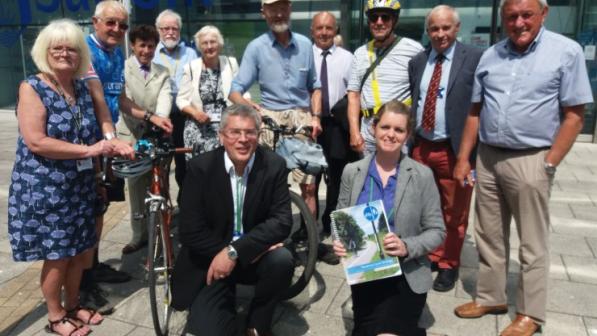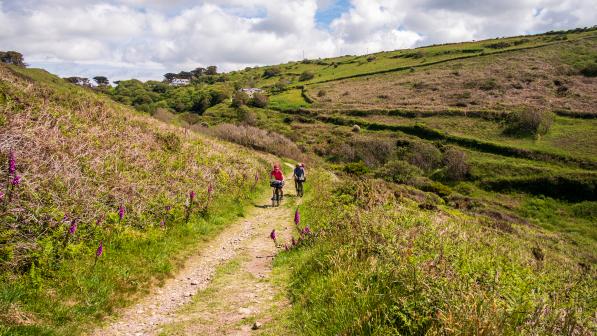Sustrans aims to remove 16,000 barriers on the NCN

Paths for everyone is Sustrans first report to look not just at the current state of the NCN over its 23 year lifetime, but also what its future could be.
It’s the conclusion of a major review and independent audit of a network that snakes 16,575 miles through England, Northern Ireland, Scotland and Wales. As a network it is easily reached, with reportedly over half of the UK population living within a mile of it, but as the Bristol based charity points out, this does not mean it is accessible to everyone.
Steps, fords, stiles, mud baths, fast roads and poor signage are just some of the obstacles holding the network back from being open to everyone.
“Historic problems such as poor surfaces, incomplete signage or barriers mean for people with mobility issues or those of us who are less physically active, there may as well be a ‘no entry’ sign on their local path,” says Sustrans CEO, Xavier Brice. “We have two priorities – to make the Network safer and more accessible for everyone.”
We have two priorities – to make the Network safer and more accessible for everyone.
Xavier Brice, Sustrans CEO
Despite these barriers, the network still enables over 780 million journeys each year from the Shetland Islands to Land’s End, but as Mr Brice points out, with proper investment it could do so much more: “In pure transport terms, the NCN presents a huge opportunity to transform the way people travel. But the benefits of investing in the network will be seen right across government, like relieving pressure on the NHS budget.”
Just over two thirds (68 percent) of the network – 11, 271 miles – is on road, and this includes nearly 2,000 miles of busy A and B roads. This isn’t good enough, says Mr Brice, whose vision is “to make the Network traffic free and safe for a 12-year-old to use on their own.”
Currently, according to the report, only 54 percent of the network is suitable for a 12-year-old to use safely.
Overhauling the network will require removing 16,000 identified barriers. In doing so, Sustrans estimates double the number of people will use the network.
The charity says this is achievable over the next 22 years and will only require an investment of £2.8bn. This level of investment would soon be recovered, as Sustrans estimates the total amount of trips would generate £7.8bn in economic and local benefits every year. This would be through reduced road congestion and health benefits associated with increased exercise, and also includes £5bn in benefits to local businesses from tourism and leisure.
Cycling UK, along with other cycling organisations such as inclusive cycling charity, Wheels for Wellbeing and British Cycling and national organisations like the Forestry Commission and Canal and River Trust, contributed to the NCN’s review.
“Cycling UK are proud to be supporting the review of the National Cycle Network. We believe that cycling can help make happier healthier communities for all and the National Cycle Network provides a great environment for new and existing cyclists alike,” said Cycling UK’s Director of Influence and Engagement, Matt Mallinder.
“Safe, signposted and traffic-light routes provide reassurance and easy navigation to discover communities by bike as well as inspiration to explore further afield.”
The review sets out 15 recommendations for local authorities, private and charitable landowners, national governments and agencies, to transform the Network, including:
- Set the tone for harmonious use of the Network by everyone.
- Remove or redesign all 16,000 barriers on the Network to make it accessible to everyone, with no barriers in place for continuous travel.
- Transform the Network by replacing existing on-road sections with new traffic-free paths or by creating quiet-way sections so it is safer for everyone.
- Ensure that where the Network is on a quiet-way section the speed limit is 20mph in built-up areas and 40mph in rural areas.
- Improve safety at crossings where the Network crosses roads or railways.
- Adopt a new quality standard to ensure path widths and surfaces are built for everyone.
- Improve signage so everyone can use the paths without a map or smartphone.
- Deliver over 50 activation projects across the UK by 2023 to improve the Network and demonstrate change.
- Introduce a process for de-designation of parts of the Network that cannot be improved – and a clear process for incorporating new routes that fill gaps or make new connections.
- Make it easier for people using the Network to feed back on its condition – and use this insight to improve it.
- Promote the Network to new users.
- Encourage greater community involvement in designing, developing and maintaining the Network.
- Provide open data on the Network.
- Report regularly on the impact of the Network in improving everyone’s lives and places.
- Establish clear governance to bring together land managers, funders, users and others.


